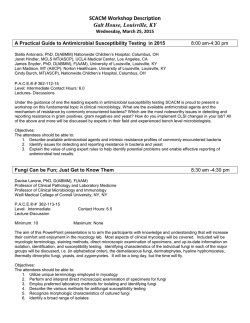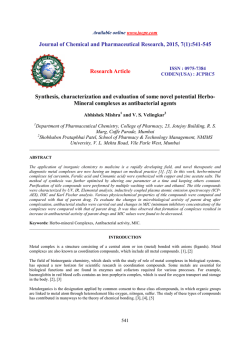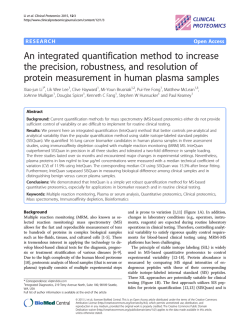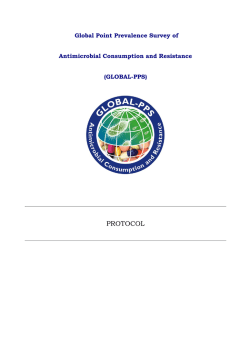
In vitro antibacterial activity of peptides isolated from Areca catechu
Available online at www.scholarsresearchlibrary.com Scholars Research Library Der Pharmacia Lettre, 2015, 7 (1):1-7 (http://scholarsresearchlibrary.com/archive.html) ISSN 0975-5071 USA CODEN: DPLEB4 In vitro antibacterial activity of peptides isolated from Areca catechu Linn. Dibya Jyoti Hazarika and Kaushal Sood* Centre for Studies in Biotechnology, Dibrugarh University, Dibrugarh, Assam _____________________________________________________________________________________________ ABSTRACT Antimicrobial Peptides (AMPs) from plantsrepresent a group of diverse biologically active protein molecules. In recent years, a wide variety of AMPs have been isolated and characterized for their biological properties from variousplants. The current study was designed to screen Areca catechu Linn.for the presence of antibacterial peptides. The present works is most probably the first to report two antimicrobial peptides (68 kDa and 65 kDa) from A. catechu Linn. with activity against S. epidermidis, E. coliand P. mirabilis. Keywords: Antimicrobial peptides, Areca catechu, SDS-PAGE, Antibacterial activity _____________________________________________________________________________________________ INTRODUCTION Nature may be regarded as the best combinatorial chemist with its numerous therapeutic agents to help man in his struggle for survival against microbial infections. The history of use of natural products as therapeuticsis as ancient as human civilization and, for a long time, minerals, plants and animal products have been the main sources of drugs [1]. Medicinal plants have played a prime role in maintaining human health through their inclusion in human diet as vegetables, spices, tonics and masticatory products. Several preclinical and clinical studies have examined various medicinal properties such as anti-inflammatory, antioxidant, anti-microbial, anthelmintic, anti-cancer, cytoprotective, hepatoprotective, etc. in a huge number of medicinal plants. The medicinal properties of plants have often been attributed to their secondary metabolites, also often referred to as the phytochemicals [2]. Apart from the biologically active phytochemicals, Antimicrobial Peptides (AMPs) from plantsrepresent a group of diverse biologically active protein molecules. Antimicrobial peptides have been recognized as potent alternatives to the contemporary antibiotics [3, 4].AMPs are small molecular weight proteins which have broad spectrum antimicrobial activity against bacteria, viruses, and fungi. These peptides are reported to be evolutionarily conserved and have both hydrophobic and hydrophilic sidechains that enable the molecule to be soluble in aqueous environments and at the same time facilitate their entry into the lipid-rich membranes [5].AMPs target a previously under-appreciated ‘microbial Achilles heel’, a design feature of the microbial cellular membrane. This feature distinguishes broad species of microbes from multicellular plants and animals [4]. The present study was aimed at screening the crude protein extracts of Areca catechu Linn.forantimicrobial peptides as the same have not yet been reported for the antimicrobial peptides. Areca catechu Linn.is a tree with an annulate stem. The stem is surrounded by a crown of pinnate leaves. The leaflets are numerous, the petioles expanded into a broad, tough, sheath-like growth at the lower end; the inflorescence is a spathe which is compressed and glabrous; the spadices are much-branched, bearing ebracteate male and female flowers. The male flowers are small and numerous; the female flowers are solitary or in groups of two or three and much larger than the male; bisexual flowers have also been recorded; the fruits are ovoid or oblong, smooth and orange or scarlet when fully ripe. They are single-seeded and the endosperm or seed-kernel, popularly called the "arecanut", is greyish brown and ruminate, with reddish brown lines. It isa widely cultivated plant in eastern countries like India, Bangladesh, Ceylon, Malaya, the Philippines and Japan. In India, the plant is widely distributed in coastal regions, from Maharashtra to Kerala and Tamil Nadu. It also grows in the Deccan Plateau, 1 Scholar Research Library Dibya Jyoti Hazarika and Kaushal Sood Der Pharmacia Lettre, 2015, 7 (1):1-7 ______________________________________________________________________________ Assam, Meghalaya, West Bengal, and the Andaman and Nicobar Islands. The traditional uses of the plant are summarized in Table 1. Table 1: Medicinal uses of the plant Plant part used Used as Raw Nut Kernel of green fruit Root Ointment(in combination with other ingredients) Along with opium Astringent and stimulant (chewed with betel peeper and lime) Juice Used in Anaemia, fits, leucoderma, leprosy, obesity and worms Nasal ulcers Intestinal trouble Regular purpose Liver diseases Figure 1: Areca Catechu Linn. Tree (Insert: Nuts) Vernacular Names: English : Beetel nut, Areca nut Assamese : Tamol, Guwa Sanskrit : Akoth Bengali :Supari Hindi : Chamarpushpa, Supari Manipuri :Kwapambi, Kwamaru Marathi : Pophal, Pugaphal, Supari Botanical Classification: Kingdom : Plantae Division : Magnoliophyta Class : Liliopsida Sub-class : Arecidae Order : Arecales Family : Arecaceae Genus : Areca Species : catechu Linn. 2 Scholar Research Library Dibya Jyoti Hazarika and Kaushal Sood Der Pharmacia Lettre, 2015, 7 (1):1-7 ______________________________________________________________________________ MATERIALS AND METHODS Plant Material Nuts of Areca catechu were selected for the present study. The nuts were collected and washed immediately with sterile distilled water. The outer cover was removed and the kernel was weighed and preserved aseptically for further use. Extraction of Total Proteins The total proteins were extracted from the kernel by the method of Aliahmadiet al.(2011) [6]. Protein isolation buffer containing 50 mM phosphate buffer (pH 7), 2 mM EDTA, 5% glycerol and 50 mMNaClwas used for extracting proteins. Extraction buffer (cold) was added to the material (10:1 v/w) and homogenized in a mortar pestle. The mixture was incubated 2 hours at 4ºC in a shaking incubator (Certomat, Sartorius Stedim, Germany). It was then centrifuged at 12,000 rpm for 20 min at 4ºC (Sigma 3-30K Refrigerated Centrifuge, Germany). The supernatant was sterilized using 0.22 µm membrane filter. The crude protein solution thus obtained was stored at 4ºC until further use. Estimation of Proteinsby Bradford Assay The proteins in the crude solutionwere quantified by the Bradford assay[7]. A standard curve was prepared using bovine serum albumin (BSA) with concentrations in the range of 100 to 2000 µg/ml. 2.0 ml of the assay reagent was mixed with 40 µl of the standard solution and incubated for 15 minutes.The absorbance was measured at 595 nm using a spectrophotometer (Shimadzu UV-1800 spectrophotometer, Japan). The regression equation for absorbance versus concentration was determined and the protein content in the sample was calculated using the equation. In vitro Antibacterial Activity Assay Test Organisms Standard bacterial strains were obtained from IMTECH, Chandigarh. Two Gram Positive bacteria- Bacillus subtilis MTCC 441; Staphylococcus epidermidis MTCC 435 and two Gram Negative bacteria-Escherichia coliMTCC 739; Proteus mirabilis MTCC 1429 were used for the study. The cultures of test organisms were maintained in Nutrient Broth (Hi-Media, Mumbai). Antimicrobial Susceptibility Test The samples were screened for antibacterial activity in vitro by agar-well diffusion method [8].Muller Hinton Agar (Hi-Media, Mumbai) was prepared according to manufacturer’s instructions. Glass petri plates (Diameter 100 mm) were sterilized prior to use. 20 ml ofagar medium was poured into the petri plates under laminar air flow in a biosafety hood and was allowed to solidify. After solidification,100 µl of inoculum was spread on the agar plate using a sterile L- spreader. Wells (diameter 6 mm) were boredin the agar plates using a sterile glass well-borer. Each well was loaded with 50 µl of the test sample. Protein extraction buffer was used as negative control and Ofloxacin (5 µg/ml) was used as the standard drug. The plates were incubated at 25°C for 24 hours after which the diameter of the zone of inhibition formed around the well was measured. The experiment was repeated thrice and the mean diameter of the zone of inhibition was determined. Purification of Antibacterial Peptides The proteins present in the crude solution were precipitated using acetone. Acetone solution was cooled to -20°C and was added to the protein solution in 1:1, 1:2 and 1:4 (v/v) ratios. The mixture was then centrifuged at 20,000 rpm for 5 minutes at 4 oC. The protein palette was allowed to air dry and re-dissolved in phosphate buffer.The protein fractions thus obtained were screened for antibacterial activity as mentioned in the previous section. Determination of Minimum Inhibitory Concentration (MIC) and Minimum Bactericidal Concentration (MBC) MIC and MBC were determined by the procedure described by Ericsson and Sherris (1971) [9] with some modifications. Two-fold dilutions of the protein fraction with antibacterial activity were prepared in nutrient broth. 50 µl of the inoculums were added to each test tube. Positive control tubes were prepared with 1 ml of broth and 50 µl of the inoculums and no sample. Negative control tubes for each dilution were also prepared and were maintained without the inoculums. All tubes were incubated at 37°C for 18 hours and then examined for growth by observing for increase in turbidity at 620 nm.The minimum concentration of protein fraction which exhibited the inhibition of bacteria was considered as the minimum inhibitory concentration (MIC). A loopful from each of the test and control tubes was then streaked onto petri plates containing nutrient agar medium. The plates were incubated at 37°C for 18 hours. After incubation, the minimum concentration that did not show the growthof bacteria was considered as minimum bactericidal concentration (MBC). 3 Scholar Research Library Dibya Jyoti Hazarika and Kaushal Sood Der Pharmacia Lettre, 2015, 7 (1):1-7 ______________________________________________________________________________ Determination of temperature stability of the proteins: The protein fraction with antimicrobial activity was subjected to thermal treatment by incubation at -20°C, 0°C, 8°C, 25°C, 40°C and 70°C for 4 hours. The concentration of proteins in the sample was determined before and after temperature treatment by the Bradford assay [7] as described in the previous sections. The sample was also assayed for antimicrobial activity by methods outlined in the previous sections. Characterization of Antibacterial Peptides by SDS- PAGE The antimicrobial peptides present in the protein fraction were characterized by SDS- PAGE [10]. Electrophoresis was performed at 100 volts for 55 minutes. At the end of the run, the protein bands were visualized by silver staining [11]. RESULTS AND DISCUSSION A standard graph for Bradford assay was prepared using 2000 µg/ml stock of Bovine Serum Albumin (BSA) and the amount of proteins in the solution was calculated from the following regression equation (Figure 2)1.40 1.20 A 595 1.00 0.80 0.60 y = 0.0006x - 0.0142 R² = 0.99 0.40 0.20 0.00 0 500 1000 1500 2000 2500 Concentration of BSA (in µg/ml) Figure 2: Bradford Assay: Standard Graph Y= 0.0006 x – 0.0142; R2 = 0.99 where, y = absorbance at 595 nm, x= concentration in µg/ml The total protein content ofA. catechu kernel was determined to be 1205.89 ± 29.17µg/ml. The total proteins of A. catechu were observed to inhibit the test strains except B. subtilis. Among the Gram Positive and Gram Negative bacteria, Gram Negative bacteria were observed to be more susceptible to the proteins of A. catechu (Figure 3). The negative control did not inhibit the test strains. The proteins present in the crude solution were fractionated by precipitation with acetone at different ratios and the individual fractions were then screened for protein content and antimicrobial activity (Table 2). The results showed that the proteins were absent in fractions 1 and 3 which were obtained with 1:1 and 1:4 ratio (v/v) of acetone respectively, while the fraction 2 obtained using acetone in 1:2 ratio (v/v) contained 500.33 ± 21.67µg/ml of proteins.Moreover, only fraction 2 exhibited the inhibition of S. epidermidis, E. coli and P. mirabilis.Similar to the case of the crude sample, B. subtilis was not inhibited by any of the fractions. 4 Scholar Research Library Dibya Jyoti Hazarika and Kaushal Sood Der Pharmacia Lettre, 2015, 7 (1):1-7 ______________________________________________________________________________ Diameter of Zone of Inhibition (in mm) 16 14 12 10 8 6 4 2 0 B. subtilis S. epidermidis E. coli P. mirabilis Figure 3: Antimicrobial activity of Total Proteins of A. catechu Table 2: Protein Content and Antimicrobial activity of Proteins Fractions of A. catechu Diameter of zone of inhibition (in mm) B. subtilis S. epidermidis E. coli P. mirabilis na na na na 500.33 ± 21.67 na 10 ± 1 12 ± 1 11 ± 1 na na na na na= No Activity Results expressed as mean ± sd of three replicates Fraction Sample: Acetone (v/v) 1 2 3 1:1 1:2 1:4 Protein Content (in µg/ml) Figure 4: Effect of Temperature on Antimicrobial Activity of A. catechu Fraction 2 The minimum concentration of fraction 2 required inhibiting the growth of the bacterial strains and the concentration required to exert bactericidal effect was determined and is presented in Table 3. The MIC values were observed to be in the range of 250 µg/ml to 500 µg/ml while the MBC values were observed to range from 1000 µg/ml and above. Among the three strains, P. mirabilis was observed to be more susceptible to the AMPs obtained from A. catechu (MIC= 250µg/ml; MBC= 1000 µg/ml). The results suggest that the AMPs from A. catechu may have potential applications against E. coli and P. mirabilis which are commonly responsible for various infections of gut and urinary tract in humans, especially in immune-compromised individuals.The effect of temperature on the 5 Scholar Research Library Dibya Jyoti Hazarika and Kaushal Sood Der Pharmacia Lettre, 2015, 7 (1):1-7 ______________________________________________________________________________ activity of the antimicrobial peptides of fraction 2 was studied and the results are presented in Figure 4. It was observed that fraction 2 retained antimicrobial activity against the test strains even after exposures to extremely low (- 20 oC) and extremely high (70 oC) temperatures for 4 hours. Optimum activity was observed in the temperature range of 25 oC to 40 oC. The AMPs obtained in fraction 2 were further characterized by SDS-PAGE (Figure 4). The electrophoretogram revealed the presence of two polypeptides of 68 kDa and 65 kDa. Table 3: MIC and MBC of the Antimicrobial Peptides from A. catechu Strain S. epidermidis E. coli P. mirabilis MIC (in µg/ml) 500 500 250 MBC (in µg/ml) > 1000 1000 1000 68 65 Figure 5: SDS-PAGE Electrophoretogram of A. catechu Protein Fraction 2 (Lane 4 & 5) Lane 2 (Marker) The main groups of antimicrobial peptides found in plants are grouped into three types–thionins, defensins and lipid transfer proteins[12].The thionins constitute a family of basic peptides with low molecular weight (~5 kDa) and are rich in basic and sulfur-containing residues. The members of this group share high sequential and structural similarities and exert toxic effects against bacteria, fungi, yeast, animal and plant cells. Several thionins have been isolatedfrom barley, wheat, oats, rye and sugar beet [13- 17]. Other reported thionins from plants includeviscotoxins and phoratoxins from mistletoe species, and crambin from the cruciferous plant Crambeabyssinica. Thionins from cereals and Pyrulariapuberaand some other dicotyledonous plants have been shown to contain disulfide bonds.Thioninhave been reported to exert their effects on the membrane through binding with phospholipids[18]. Another group of plant antimicrobial peptides known as thedefensinsare small 45–54 amino acids long cationic peptidesthat are widely distributed among dicots and monocots.These were originally grouped with the thionins and were defined as -thionins. The lipid transfer proteins have the ability to facilitate the transfer of phospholipids among natural or artificial membranes and by linking to fatty acids invitro[12]. Plant lipid transfer proteins are quite abundant in plants and include two groups, LTP1 and LTP2. Members of the plant LTP1 family are about 10 kDa in size and consist of 90-95 amino acids.They are basicin nature with isoelectric points between 9 and 10.The LTP2 family members showsimilarity with the LTP1 family but are only about 7 kDa in size. They contain about 70 amino acids on average and a signal peptide. Antifungal and antibacterial activities have been reported for LTPs of various plants including barley, maize, spinach, and A. thaliana[19- 21]. The peptides reported in the present work are distinct from the major classes of AMPs. Further works are required to identify the sequence of the peptides for understanding their structure and biological functions. Although A. catechu has been reported for its various medicinal properties, specially antibacterial and antiviral activities[22- 24] to the best of our knowledge, there have been no reports onthe antibacterial activity of the peptides isolated from the kernels of the A. catechu nuts. Therefore, the present works is most probably the first to report two antimicrobial peptides (68 kDa and 65 kDa) from A. catechu. Further works towards the purification and sequencing of the antimicrobial peptides reported in the present study are being pursued. 6 Scholar Research Library Dibya Jyoti Hazarika and Kaushal Sood Der Pharmacia Lettre, 2015, 7 (1):1-7 ______________________________________________________________________________ REFERENCES [1] S. M. K. Rates, Toxicon, 2001, 39 (5): 603-613. [2] M. M. Cowan, Clin. Microbiol.Rev.,1999, 12 (4), 564–582. [3] H.G. Boman,Annu Rev Immunol, 1995, 13, 61–92 [4] M. Zasloff, Nature, 2002, 415, 389–395 [5] A. Izadpanah, R. L. Gallo,. Journal of the American Academy of Dermatology, 2005, 52(3), 381-390. [6]A. Aliahmadi, R. Roghanian, G. Emtiazi, A. Ghassempour, Iranian journal of microbiology,2011,3(2),104. [7] M. M. Bradford, Anal Biochem, 1976,72, 248–254 [8] T. I. Mbata, L. Debiao, A. Saikia, African Journal of Biotechnology, 2008, 7 (10),1571-1573. [9] J. M. Ericsson,J. C. Sherris, Acta PatholMicrobiol Scand, 1971,217 (supp l), 1-90. [10] U. K. Laemmli, Nature, 1970, 227, 680-685. [11] S. F. D. S.Groth, R. G. Webster, A. Datyner, BiochemBiophys Acta,1963, 71, 377–391. [12] M. S. Castro, W. Fontes, Protein and Peptide Letters,2005, 12(1), 11-16. [13] F. J. Colilla, A. Rocher, E. Mendez, FEBS Lett.1990,270, 191–194. [14] E. Mendez, A. Moreno, F. Colilla, F. Pelaez, G. G. Limas, R. Mendez, F. Soriano, M. Salinas, C. De Haro, Eur. J. Biochem, 1990, 194, 533– 539. [15] R. Fernandes de Caleya, B. Gonzalez-Pascual, F. Garcia-Olmedo, P. Carbonero.Appl. Microbiol.1972, 23, 998– 1000. [16] K. M. Kragh, J. E. Nielsen, K. K. Nielsen, S. Dreboldt, J. D. Mikkelsen,Mol. Plant- Microbe Interact, 1995, 8, 424– 434. [17] Y. Zhang, K. Lewis. FEMS Microbiol. Lett.,1997,149, 59–64. [18]B. Stec, O. Markman, U. Rao, G. Heffron, S. Henderson, L.P.Vernon,V.Brumfeld, M. M. Teeter, J Pept Res,2004,64, 210–224. [19] F. R. Terras, I. J. Goderis, F. Van Leuven, J. Vanderleyden, B. P. Cammue, W.F.Broekaert,Plant Physiol 1992, 100, 1055–1058. [20] A. Molina, A. Segura, F. Garcia-Olmedo,FEBS Lett,1993,316, 119–122. [21] A. Segura, M. Moreno, F. Garcia-Olmedo, FEBS Lett.,1993, 332, 243–246. [22] H. Lalithkumari, M. Sirsi, Indian Journal of Experimental Biology,1965. 7, 66. [23] J.L.N. Sastry;DravyagunaVijnana: Fundamental Principles of Pharmaco-therapeutics in Ayurveda, Varanasi, Chaukham bhaOrientalia, India,2005,2. [24]R. Reena, N. Authikat, A. Michael, Pharmacognosy, 2009, 1(1), 42-45. 7 Scholar Research Library
© Copyright 2025





